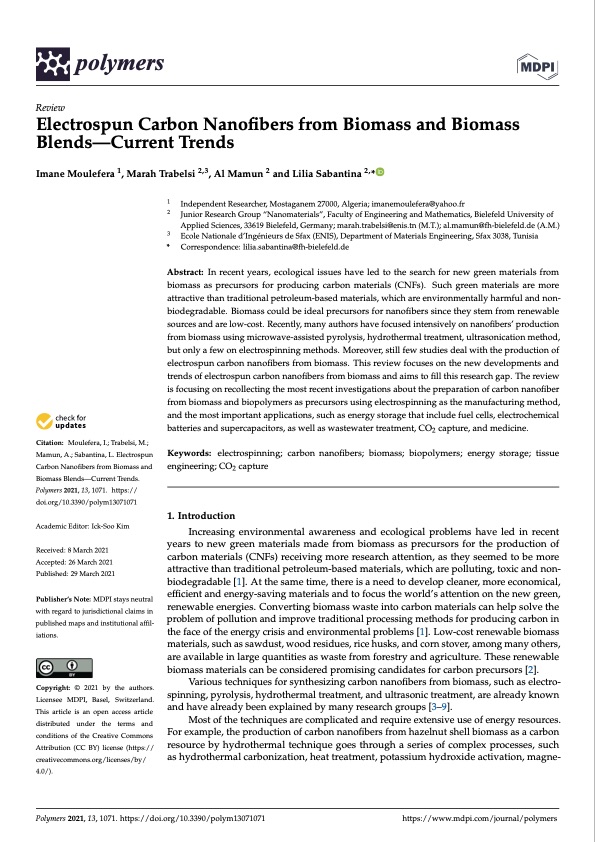
PDF Publication Title:
Text from PDF Page: 001
polymers Review Electrospun Carbon Nanofibers from Biomass and Biomass Blends—Current Trends Imane Moulefera 1, Marah Trabelsi 2,3, Al Mamun 2 and Lilia Sabantina 2,* Citation: Moulefera,I.;Trabelsi,M.; Mamun, A.; Sabantina, L. Electrospun Carbon Nanofibers from Biomass and Biomass Blends—Current Trends. Polymers2021,13,1071. https:// doi.org/10.3390/polym13071071 Academic Editor: Ick-Soo Kim Received: 8 March 2021 Accepted: 26 March 2021 Published: 29 March 2021 Publisher’s Note: MDPI stays neutral with regard to jurisdictional claims in published maps and institutional affil- iations. Copyright: © 2021 by the authors. Licensee MDPI, Basel, Switzerland. This article is an open access article distributed under the terms and conditions of the Creative Commons Attribution (CC BY) license (https:// creativecommons.org/licenses/by/ 4.0/). 1 2 Abstract: In recent years, ecological issues have led to the search for new green materials from biomass as precursors for producing carbon materials (CNFs). Such green materials are more attractive than traditional petroleum-based materials, which are environmentally harmful and non- biodegradable. Biomass could be ideal precursors for nanofibers since they stem from renewable sources and are low-cost. Recently, many authors have focused intensively on nanofibers’ production from biomass using microwave-assisted pyrolysis, hydrothermal treatment, ultrasonication method, but only a few on electrospinning methods. Moreover, still few studies deal with the production of electrospun carbon nanofibers from biomass. This review focuses on the new developments and trends of electrospun carbon nanofibers from biomass and aims to fill this research gap. The review is focusing on recollecting the most recent investigations about the preparation of carbon nanofiber from biomass and biopolymers as precursors using electrospinning as the manufacturing method, and the most important applications, such as energy storage that include fuel cells, electrochemical batteries and supercapacitors, as well as wastewater treatment, CO2 capture, and medicine. Keywords: electrospinning; carbon nanofibers; biomass; biopolymers; energy storage; tissue engineering; CO2 capture 1. Introduction Increasing environmental awareness and ecological problems have led in recent years to new green materials made from biomass as precursors for the production of carbon materials (CNFs) receiving more research attention, as they seemed to be more attractive than traditional petroleum-based materials, which are polluting, toxic and non- biodegradable [1]. At the same time, there is a need to develop cleaner, more economical, efficient and energy-saving materials and to focus the world’s attention on the new green, renewable energies. Converting biomass waste into carbon materials can help solve the problem of pollution and improve traditional processing methods for producing carbon in the face of the energy crisis and environmental problems [1]. Low-cost renewable biomass materials, such as sawdust, wood residues, rice husks, and corn stover, among many others, are available in large quantities as waste from forestry and agriculture. These renewable biomass materials can be considered promising candidates for carbon precursors [2]. Various techniques for synthesizing carbon nanofibers from biomass, such as electro- spinning, pyrolysis, hydrothermal treatment, and ultrasonic treatment, are already known and have already been explained by many research groups [3–9]. Most of the techniques are complicated and require extensive use of energy resources. For example, the production of carbon nanofibers from hazelnut shell biomass as a carbon resource by hydrothermal technique goes through a series of complex processes, such as hydrothermal carbonization, heat treatment, potassium hydroxide activation, magne- Independent Researcher, Mostaganem 27000, Algeria; imanemoulefera@yahoo.fr Junior Research Group “Nanomaterials”, Faculty of Engineering and Mathematics, Bielefeld University of Applied Sciences, 33619 Bielefeld, Germany; marah.trabelsi@enis.tn (M.T.); al.mamun@fh-bielefeld.de (A.M.) Ecole Nationale d’Ingénieurs de Sfax (ENIS), Department of Materials Engineering, Sfax 3038, Tunisia 3 * Correspondence: lilia.sabantina@fh-bielefeld.de Polymers 2021, 13, 1071. https://doi.org/10.3390/polym13071071 https://www.mdpi.com/journal/polymersPDF Image | Electrospun Carbon Nanofibers from Biomass and Biomass Blends

PDF Search Title:
Electrospun Carbon Nanofibers from Biomass and Biomass BlendsOriginal File Name Searched:
88145ac687f0c36c7096f236fabe2cba856c.pdfDIY PDF Search: Google It | Yahoo | Bing
Sulfur Deposition on Carbon Nanofibers using Supercritical CO2 Sulfur Deposition on Carbon Nanofibers using Supercritical CO2. Gamma sulfur also known as mother of pearl sulfur and nacreous sulfur... More Info
CO2 Organic Rankine Cycle Experimenter Platform The supercritical CO2 phase change system is both a heat pump and organic rankine cycle which can be used for those purposes and as a supercritical extractor for advanced subcritical and supercritical extraction technology. Uses include producing nanoparticles, precious metal CO2 extraction, lithium battery recycling, and other applications... More Info
| CONTACT TEL: 608-238-6001 Email: greg@infinityturbine.com | RSS | AMP |